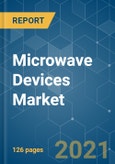The Microwave Devices Market has registered a CAGR of 3.23% over the forecast period 2021 - 2026. According to the Satellite Industry Association, in 2018, the global satellite navigation equipment industry generated about USD 93.3 billion in revenue while in 2016, it was USD 84.6 billion. In response to increasing satellite navigation equipment industry, the microwave devices market will also increase.
- Moreover, in 2018, there was a total of 88 satellites launched, an increase from the 85 satellites launched in 2016. The increasing launch of satellites is promoting the use of microwave devices, such as frequency emitting towers and satellites, for sending and receiving data signals.
- For instance, in April 2018, the Sentinel-3B satellite, built by Thales Alenia Space for the European Space Agency (ESA), was successfully launched and orbited. This satellite is featured with SRAL (Synthetic-aperture Radar ALtimeter), and MWR (Microwave Radiometer), which provides measurements to determine the topography of oceans, sea ice and bodies of water on land. This would help to improve oceanographic and atmospheric forecasts.
- Further, growing customer base owing to increasing focus towards implementation of connected technology such as IoT is anticipated to boost the market growth in upcoming years as well. This growth is characterized by optimum performance, in terms of low signal loss and high-frequency range.
- However, high production cost, and research and development expenses to improve technology are few factors which is reatraing the market to grow during the forecast period.
Key Market Trends
Space Exploration Offers Potential Growth
- Space exploration has evolved from shuttle missions and trips to the International Space Station to unmanned missions to Mars and the possibility of space tourism. In response to such evolution of space exploration where spacecraft’s tracking and communications systems are the only means with which to interact, microwaves are suitable for wireless transmission of signals of having larger bandwidth.
- Further, NASA announced plans to put the first woman on the moon in 2024 as part of the Artemis program and the program also aims to put human beings on the surface of Mars by the 2030s.
- Hence, it has led to the Deep Space Optical Communications project, led by NASA's Jet Propulsion Laboratory. This aims to develop laser communications to boost connectivity speeds for future human exploration of the solar system. In response to this, Jet Propulsion Laboratory is working on technologies for the implementation of a deep-space optical transceiver and ground receiver that will enable data rates greater than 10 times the current state-of-the-art deep-space RF system (Ka-band, a type of microwave ) for a spacecraft with similar mass and power.
- Such space projects are expected to have a positive outlook on the market and it is expected that will provide an immense opportunity in the space exploration.
North America Holds the Majority Share
- Owing to the rise in the implementation of the latest technologies such as broadband data links, and surface radars, and the existence of well-established industrial infrastructure, North America holds the major market share.
- Moreover, the spending on healthcare services in the North American region is growing, owing to the aging population that requires and demands cost-effective medical facilities, increasing the demand for microwave products such as imaging systems.
- Further, in June 2019, The Air Force Research Laboratory at Kirtland Air Force Base unveiled a weapon named Tactical High Power Microwave Operational Responder, or THOR. It is capable to disable an unmanned aerial vehicle in a fraction of second through invisible and inaudible electromagnetic wave. U.S. military bases across the globe is going to deploy this in the coming future.
- Therefore, the application of microwave devices in the North America is going to increasing, which in return will boost the market globally.
Competitive Landscape
The microwave devices market is competitive in nature, owing to the presence of global players. Some of the key vendors are L3 Technologies, Thales Group, Teledyne Technologies, Inc, Cytec Corporation and Richardson Electronics, Ltd. Huge expenditure by the governments on defense , space communication sector is expected to open new opportunities for microwave devices globally which in return will increase the competition among players. Product launches, high expense on research and development, partnerships and acquisitions, etc. are the prime growth strategies adopted by these companies to sustain the intense competition. Some of the recent developments are:
- August 2019 - Communications & Power Industries LLC (CPI) has entered into an agreement to purchase SATCOM Technologies, the antenna systems business of General Dynamics Mission Systems, Inc., a business unit of General Dynamics. This business would complement CPI’s existing portfolio of communications products for government, military, and commercial applications.
- May 2019 - API Technologies Corp has been acquired by an affiliate of AEA Investors LP. This acquisition would enhance the product portfolio and customer base of the AEA investors in terms of high-performance RF and microwave signal conditioning and electromagnetic spectrum management solutions.
Reasons to Purchase this report:
- The market estimate (ME) sheet in Excel format
- 3 months of analyst support
This product will be delivered within 2 business days.
Table of Contents
Companies Mentioned (Partial List)
A selection of companies mentioned in this report includes, but is not limited to:
- L-3 Communications
- API Technologies (AEA Investors LP)
- Thales Group
- Electron Energy Corporation
- CableFree
- Teledyne Technologies
- Toshiba Corporation
- Communications & Power Industries LLC
- Cytec Corporation
- TMD Technologies Ltd.
- Richardson Electronics Limited
Methodology

LOADING...








